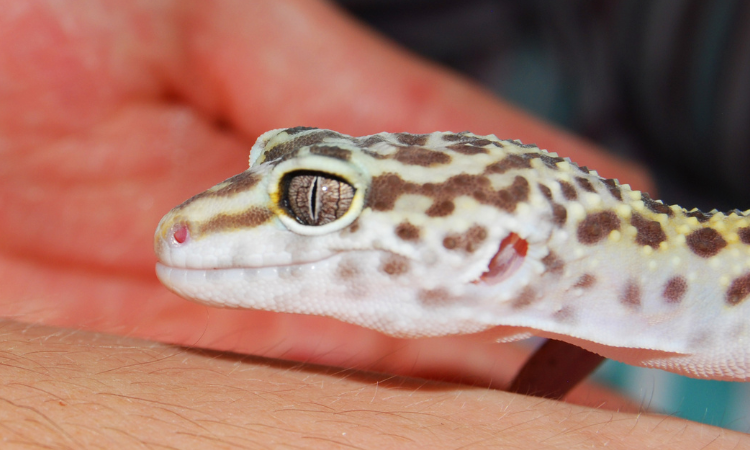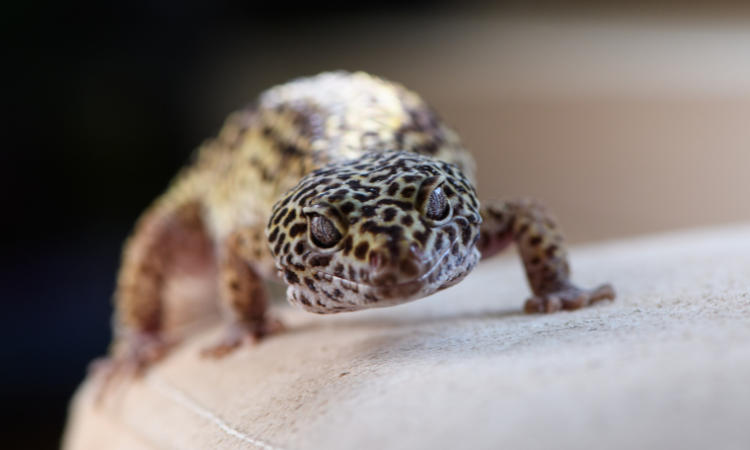Are you worried because your leopard gecko has stopped eating? Or maybe your pet just doesn’t seem to have the same appetite that they usually do. No matter what the case may be, this can be incredibly worrisome for any pet owner. While there could be any number of reasons why your gecko isn’t eating, such as stress or illness, it’s important to identify and address these issues in order to ensure that they are happy and healthy. In this blog post we will discuss some possible causes of a decreased appetite in leopard geckos, as well as strategies you should consider taking in order to get them happily feeding again!

Check the temperature of the enclosure and make sure it’s within the ideal range for a leopard gecko
Leopard geckos are known for their striking colors and fascinating patterns, but having the perfect environment for them is crucial to keep them thriving and healthy. One of the most critical aspects of a leopard gecko’s enclosure is maintaining the ideal temperature range.
Consistently checking the enclosure’s temperature will ensure that your charming reptile friend is comfortable and remains in optimal health. A well-regulated temperature not only helps in regulating their metabolism but also assists them in shedding their skin properly.
So, invest in a high-quality thermometer and provide your gorgeous leopard gecko with the warmth it deserves, making its enclosure feel like its natural habitat where it can continue to enchant you with its captivating presence.
Make sure there is enough humidity in the enclosure
The importance of maintaining the proper level of humidity within an enclosure cannot be overstated, particularly when it comes to the comfort and health of its inhabitants. Think of a tropical rainforest, a desert, or any other natural habitat: each of these environments have specific humidity requirements that can greatly impact the well-being of the plants and animals that depend on them.
In a similar manner, the creatures and plants in our care within a controlled environment like an enclosure must also have the right amount of humidity to thrive. By ensuring that you provide the appropriate level of moisture, you not only support the healthy growth of your beloved pets and plants, but also prevent the onset of various health issues, such as dehydration or mold growth.
To achieve optimal balance, always monitor the humidity levels and make necessary adjustments, using tools like humidifiers or dehumidifiers, for a flourishing and harmonious ecosystem.

Observe the gecko to see if stress or illness may be causing it to stop eating
It’s essential to pay close attention to the behavior and physical condition of your pet gecko, especially when it suddenly stops eating. Although their appetite can naturally fluctuate, a loss of appetite could indicate that the gecko is experiencing stress or illness.
Monitoring their daily activities, body posture, and appearance allows you to identify any abnormal signs that may be contributing to this change in their eating habits. In addition, keeping track of any modifications in their environment, such as temperature fluctuations, light exposure, or even disturbances from other pets, can help you pinpoint possible stressors that may be affecting your gecko’s well-being.
Ultimately, understanding the root cause of your gecko’s loss of appetite will enable you to provide the proper care and necessary adjustments to ensure their health and happiness.
Offer variety in food – try different types of live insects and offerings such as waxworms
Are you ready to take your palate on an adventurous and unforgettable gastronomic journey? Diversify your dining experience by exploring the world of edible insects, which have long been an essential source of protein and nutrients in many cultures.
Delight in the crunchy texture of roasted crickets, or savor the unique, creamy taste of waxworms. By indulging in these fascinating and eco-friendly culinary alternatives, you not only pave the way for a more sustainable future, but you also help promote an openness to diverse food cultures.
Venturing into the realm of entomophagy, or insect-eating, allows you to challenge your taste buds, contribute to a better planet, and establish a newfound appreciation for the limitless possibilities of global cuisine.
Introduce new hiding spots, such as rocks and logs, to add interest to its habitat
Introducing new hiding spots, such as rocks and logs, can breathe new life into an animal’s habitat, boosting their sense of adventure and natural instincts. These unique features create additional challenges and intrigue for the inhabitants, especially for those species that enjoy exploring and engaging with their environment.
Rocks can provide a natural camouflage for many animals, enabling them to blend effortlessly with their surroundings, while logs offer an ideal hiding spot for nocturnal creatures seeking a safe, cozy haven.
In turn, enhancing a habitat with these elements encourages the animals to exhibit their natural behaviors and contributes to their overall well-being, making it a delightful experience for animal enthusiasts to observe and enjoy.

Make sure that your gecko has plenty of floor space for walking and exploring
Ensuring your gecko has ample floor space for walking and exploring is essential for their overall well-being and happiness. By providing an expansive and diverse living environment, you are not only boosting their mental health but also allowing them to engage in their natural instincts of exploring and hunting.
Carefully selecting terrarium elements such as branches, hiding spots, and foliage will enrich their habitat while still allowing plenty of space for them to move around with ease.
Remember, a happy and active gecko means a healthy and thriving companion, so don’t hesitate to invest in a larger tank and thoughtful habitat design to guarantee their complete contentment.
In summary, in order to ensure that your leopard gecko is happy and healthy, there are many variables to consider. Begin by monitoring the temperature of your gecko’s enclosure and making sure it is within the ideal range.
Then, pay attention to the humidity levels in the cage and maintain a consistent level at all times. Take careful note of the behavior of your pet and look for any signs of stress or illness that may be causing it to stop eating. Offer a variety of food options, such as live insects or waxworms, to entice them into eating again.
Additionally, add new hiding spots like rocks or logs every few weeks so that they can explore new environments within their habitat. Finally, make sure they have plenty of open floor space to roam around and burn off energy.
By following these steps you can help guarantee that your leopard gecko will be healthy and happy!
Related posts:

Hi – I’m Erika, the lead gecko enthusiast here at Geckopedia! I write articles about pet geckos, including what to feed your leopard gecko and how to help your pet gecko live a long, happy life! I graduated with advanced degrees from UC-Berkeley, the University of Southern California (USC) and Indiana University-Bloomington, where I studied Biology and Animal Science. I use my experience to help others learn about gecko care, and I am an advocate for all topics gecko related!
